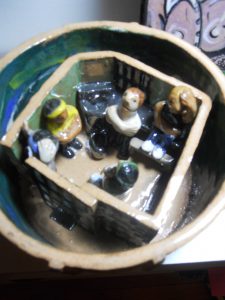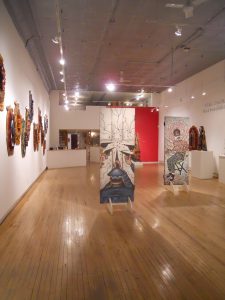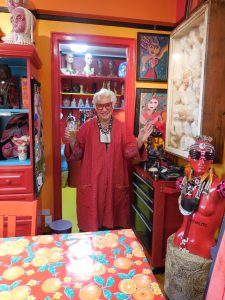
The world of outsider art is small. It’s good because someone you know always knows someone, who knows someone else. There aren’t many degrees of separation between people connected to this quirky culture.
My friend from Chicago, Susann Craig, introduced me to Sue Kreitzman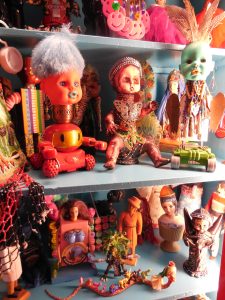 when we met up in NYC at the Outsider Art Fair in May. Sue is known for her eccentric fashion persona, her enormous collection of outsider art, and her own artwork. A documentary film, Fabulous Fashionistas, was being screened that week. It is a film about six women, with an average age of 80, who defy ageing in the most stylish ways, looking fabulous and having fun. Sue, like the other women in the film, embraced change later in life and is now clearly identifiable on the streets of NYC and London, where she lives most of the time. She is a walking piece of art, with self-designed clothing, large hand-crafted jewellery and, of course, red glasses (and red everything else).
when we met up in NYC at the Outsider Art Fair in May. Sue is known for her eccentric fashion persona, her enormous collection of outsider art, and her own artwork. A documentary film, Fabulous Fashionistas, was being screened that week. It is a film about six women, with an average age of 80, who defy ageing in the most stylish ways, looking fabulous and having fun. Sue, like the other women in the film, embraced change later in life and is now clearly identifiable on the streets of NYC and London, where she lives most of the time. She is a walking piece of art, with self-designed clothing, large hand-crafted jewellery and, of course, red glasses (and red everything else).
Sue used to be a food writer in London, but gave that up late in life to become a “closeted, obsessive, untutored artist”. Walking into her flat in NYC is shocking … in a good 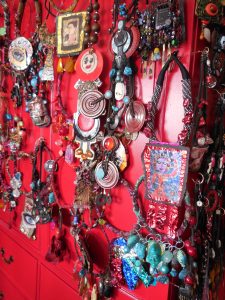 way. It is red, red, red, with glitter, sparkles, and do-dads. The walls and shelves are chock-a-block with artwork of every imaginable kind – paintings, assemblages, sculptures, dolls and many, many other things. In a word, it was extraordinary. I had the feeling that I would stand there for a very long time before I could focus on any one object in the room. As you would expect, every object in Sue’s collection has a story attached to it – who created it, the joy of discovery, her enjoyment of the work.
way. It is red, red, red, with glitter, sparkles, and do-dads. The walls and shelves are chock-a-block with artwork of every imaginable kind – paintings, assemblages, sculptures, dolls and many, many other things. In a word, it was extraordinary. I had the feeling that I would stand there for a very long time before I could focus on any one object in the room. As you would expect, every object in Sue’s collection has a story attached to it – who created it, the joy of discovery, her enjoyment of the work.
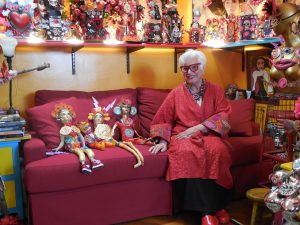 But wait – there’s more! Sue has her own studio that is even more tightly packed (if that were possible) with her own creations. Most of Sue’s artwork is of women and about women. She says she fashions friends, strangers, self-portraits, heroines and imagined goddesses and decorates them with symbols made from “junk”. (I would describe it as glittery, colourful junk!) There are decorated dolls and doll heads everywhere. It is both disorienting and fascinating to see repetition of an idea or a technique in an effort, I suppose, to understand it fully. Most images are joyful and humorous, like Sue herself. It was an unexpected and colourful (red) delight to experience all that is “Sue Kreitzman”.
But wait – there’s more! Sue has her own studio that is even more tightly packed (if that were possible) with her own creations. Most of Sue’s artwork is of women and about women. She says she fashions friends, strangers, self-portraits, heroines and imagined goddesses and decorates them with symbols made from “junk”. (I would describe it as glittery, colourful junk!) There are decorated dolls and doll heads everywhere. It is both disorienting and fascinating to see repetition of an idea or a technique in an effort, I suppose, to understand it fully. Most images are joyful and humorous, like Sue herself. It was an unexpected and colourful (red) delight to experience all that is “Sue Kreitzman”.



 I introduced you to the ceramic sculptures of Canadian artist, Serge von Engelhardt, in my last blog. I would like to show you more of his work (e.g., photo to the right). But first, I have something to say about another artist, Eugene von Bruenchenhein (American outsider artist, 1910-1983). I am a big fan of von Bruenchenhein’s work, and his wide-ranging experimentation with painting, sculptures and ceramics. He is generally known for his furniture models made of chicken bones (!) and the photographs of his wife, dressed up as a glamour girl. Like so many other outsider artists, von Bruenchenhein worked at odd jobs to support himself and his wife. He dug clay from nearby construction sites to make his ceramic work and fired his creations in his coal-burning kitchen oven. The grey sculpture to the right is one of his pieces.
I introduced you to the ceramic sculptures of Canadian artist, Serge von Engelhardt, in my last blog. I would like to show you more of his work (e.g., photo to the right). But first, I have something to say about another artist, Eugene von Bruenchenhein (American outsider artist, 1910-1983). I am a big fan of von Bruenchenhein’s work, and his wide-ranging experimentation with painting, sculptures and ceramics. He is generally known for his furniture models made of chicken bones (!) and the photographs of his wife, dressed up as a glamour girl. Like so many other outsider artists, von Bruenchenhein worked at odd jobs to support himself and his wife. He dug clay from nearby construction sites to make his ceramic work and fired his creations in his coal-burning kitchen oven. The grey sculpture to the right is one of his pieces.

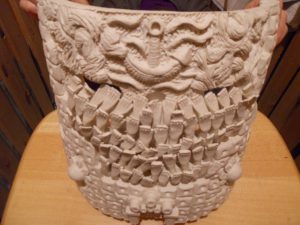
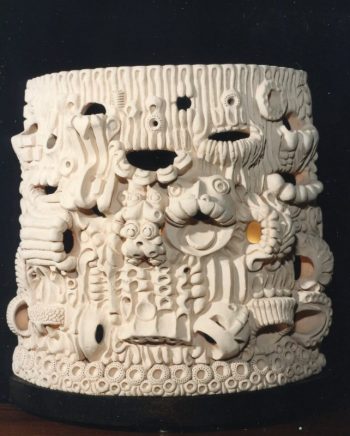 was blessed to be contacted by one of Serge von Engelhardt’s daughters. Even better, I had an opportunity to see some of his original porcelain sculptures. They count among the most beautiful creations I have ever seen and I am delighted to introduce him to you.
was blessed to be contacted by one of Serge von Engelhardt’s daughters. Even better, I had an opportunity to see some of his original porcelain sculptures. They count among the most beautiful creations I have ever seen and I am delighted to introduce him to you.



